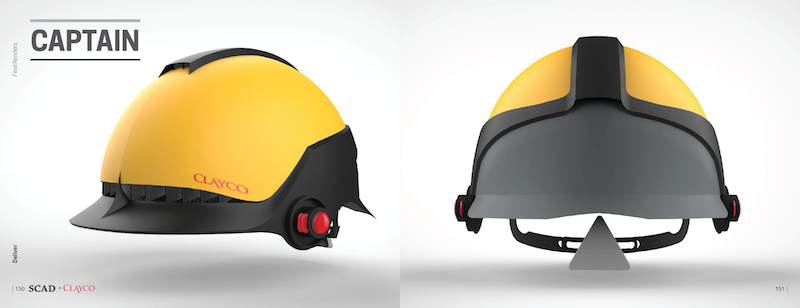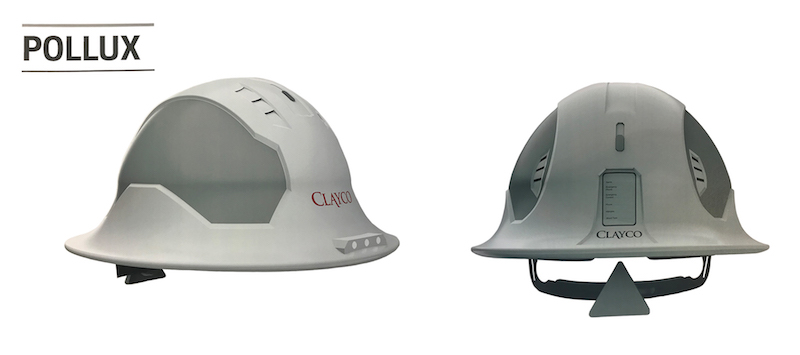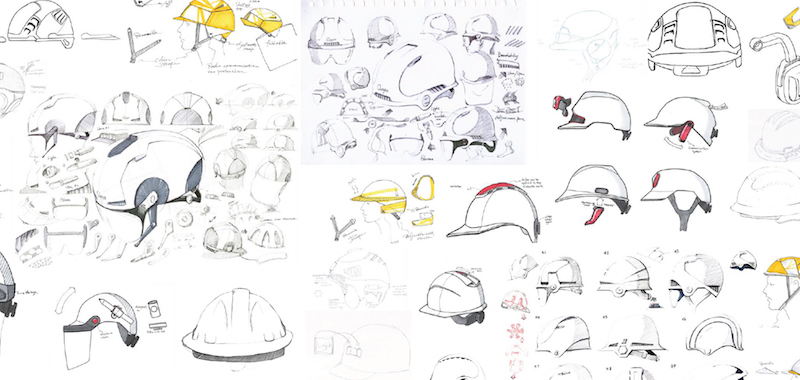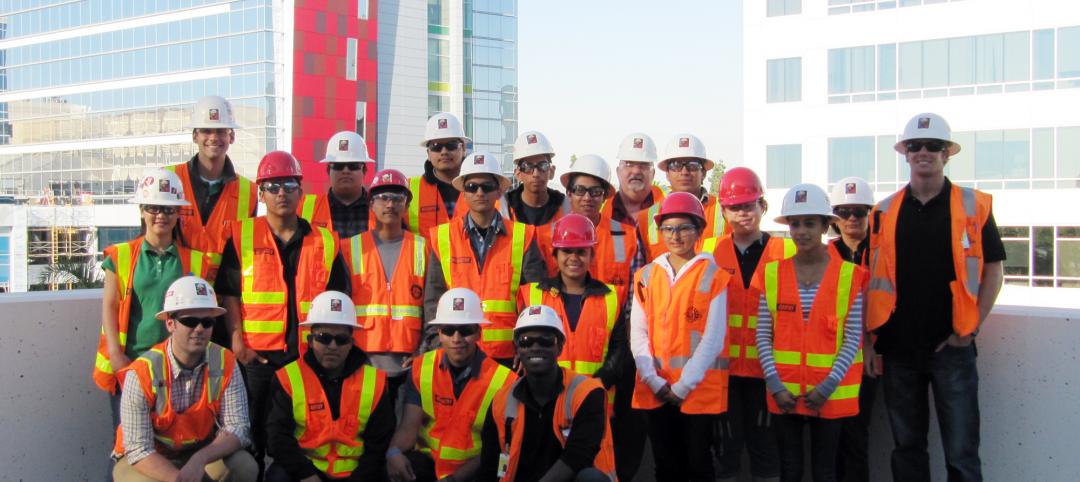The construction engineering firm Clayco is vetting manufacturers to produce what it’s calling the “hard hat of the future,” which Clayco has developed with a team of 14 students and two faculty members at the Savannah (Ga.) College of Arts and Design (SCAD).
The global hard-hat market is expected to hit $3.19 billion in sales in 2025, from $2.1 billion in 2016. Clayco has been investigating improvements in hard-hat design for more than a year, starting with a evaluation of different design trends worldwide. “We concluded that we might be better off designing a new helmet ourselves,” says Todd Friis, Clayco’s Vice President of Risk Management.
Clayco had been involved in numerous construction projects with SCAD, and also supports the school’s sustainability efforts, says Paul Runko, Collaboration Manager at SCADpro, the school’s industry partnership department.
To gain a better understanding on how construction workers use their hard hats, the students visited Clayco’s jobsite for a 14-story residence hall at SCAD’s Atlanta campus to observe and interview the labor. “For many of our students, this was the first time they had ever put on a hard hat,” says Runko.
SCAD also created an online survey that received 188 responses from workers at various locations around the country.
What the research found was that while existing hard hats are safe, too often workers aren’t wearing them because, they say, the hats are uncomfortable or too hot. What the student team also discovered was how avidly workers personalize their hats, usually with stickers. And many of the workers polled or interviewed wear sunglasses on the job, which can affect the wearability of the helmets.
Charu Pardasani a researcher, planner, and documentarian on the Clayco-SCAD team, says that the students came up with 10 conceptual and abstract ideas, from which they developed eight hard hat concepts. Clayco has selected two prototypes on which to move forward:

Clayco has selected two hard hat designs, The Captain and Pollux, to manufacture. These were chosen from eight concepts. Image: Clayco

Pollux, whose design was based on workers’ need for adaptability. The customizable design allows users to attach a magnetic LED light or mount a GoPro camera. Pollux has a rotatable, transparent full brim that provides shade and visibility. The prototype includes a chin strap, not exactly a feature workers were clamoring for, but one that is included to enhance users’ comfort and to keep the hats on their heads, especially in high-wind situations.
Captain, the second prototype, features a completely different design. It’s more like a helmet, with vents at the top and the brim. This hat also has portals for multiple accessory attachments.
Friis says that, in choosing these two models, Clayco considered weight, ventilation, lighting, and attachments. (Neither of the prototypes has a face shield, but one can be attached to each.) He adds that Clayco paid particular attention to back-of-head protection during the design phase.
The cost of the new hard hats, and when they might be available for sale, has yet to be determined. Runko notes that during the 10-week design period, a group of students was dedicated to selecting materials with an eye toward affordability.
Clayco’s involvement can be seen as part of its broader effort to improve jobsite safety. That effort got a boost from a $1 million five-year grant that Clayco and the Washington University School of Medicine in St. Louis received from the National Institute of Occupational Safety and Health and CPWR The Center for Construction Research and Training.
In 2013-2014, Clayco and the school had conducted a study of three of Clayco’s jobsites in St. Louis to observe and measure how ergonomic programs were being administered and complied with. Ann Marie Dale, an Associate Professor at the medical school, explains that ergonomic injuries occur over time from the gradual and repetitive wear and tear on the body. They can include such injuries as lower-back strain, rotator cuff tears, and trigger finger deterioration.
After seeing the results of this survey, Dale and Friis met in the spring of 2017 to discuss “interventions” that might help reduce such injuries. A program for that purpose was rolled out to all of Clayco’s job sites over the course of the following year. Dale and her team continued to monitor progress at the three “control” jobsites in St. Louis. (She was accompanied on jobsites by ergonomics experts who could answer workers’ questions.)
Dale says that it took longer than anticipated to develop the safety literature to disseminate to the jobsites, as well as a training regimen. “This is not going to be a quick fix,” she concedes. Friis declined to disclose specific data about jobsite safety except to say that, as of May 2019, three-quarters of Clayco’s active construction projects were injury-free. “It’s not perfect, but the results speak for themselves.”
Dale adds that there is interest among other construction companies to adopt the Model program that UWash and Clayco have developed.
Related Stories
| Apr 25, 2012
Thornton Tomasetti/Fore Solutions provides consulting for Biologics Support Center
Project receives LEED Gold Certification.
| Apr 25, 2012
McCarthy introduces high school students to a career in construction
High school students from the ACE Mentoring Program tour the new CHOC Children’s Patient Tower in Orange, Calif.
| Apr 25, 2012
Missner Group names McCrory VP of property management
McCrory will be responsible for overseeing the financial and operational needs of the firm’s commercial real estate portfolio which includes more than two million square feet of property.
| Apr 25, 2012
Rogers joins Morgan/Harbour as senior project manager
Rogers will also manage the construction process and daily activities as well as act as the interface between the subcontractors, owners, municipalities and regulatory agencies
| Apr 25, 2012
J.C. Anderson selected for 50,000-sf build out at Chicago’s DePaul University
The build-out will consist of the construction of new offices, meeting rooms, video rooms and a state-of-the-art multi-tiered Trading Room.
| Apr 24, 2012
ULI Real Estate Consensus Forecast, projects improvements for the real estate industry through 2014
Survey is based on opinions from 38 of the nation’s leading real estate economists and analysts and suggests a marked increase in commercial real estate activity, with total transaction volume expected to rise from $250 billion in 2012 to $312 billion in 2014.
| Apr 24, 2012
Roofing Supply Group acquired by Clayton, Dubilier & Rice
RSG provides a complete offering of residential and commercial roofing materials and related supplies.
| Apr 24, 2012
McLennan named Ashoka Fellow
McLennan was recognized for his work on the Living Building Challenge.
| Apr 24, 2012
AECOM design and engineering team realizes NASA vision for Sustainability Base
LEED Platinum facility opens at NASA Ames Research Center at California’s Moffett Field.
| Apr 23, 2012
Vegas’ CityCenter called financial ‘black hole’
Two and a half years ago, stockholders filed six lawsuits after the stock price fell from $99.75 on Oct. 9, 2007, to $1.89 on March 5, 2009. Bondholders sued over similar steep losses.

















